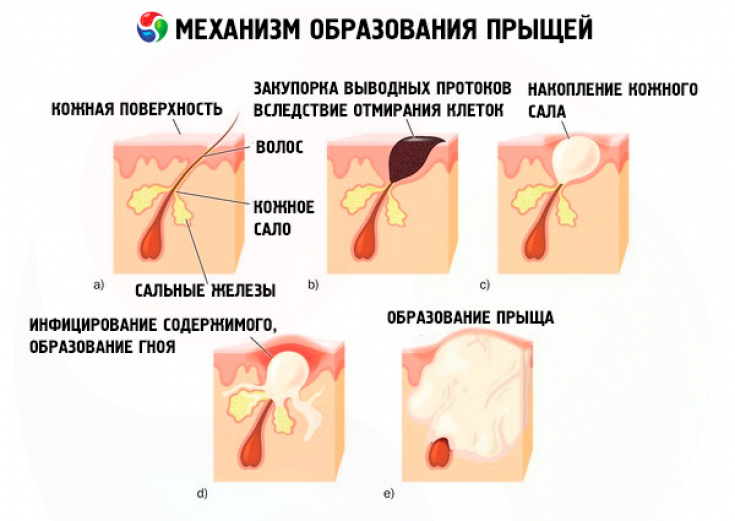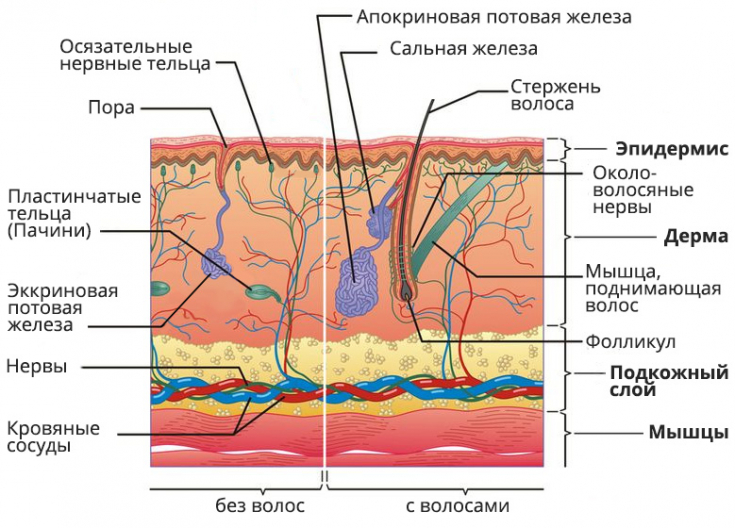Diseases of the sebaceous and sweat glands are among the most common pathologies in the practice of a cosmetologist.
Skin glands play an important role in the protection, removal of toxic substances and thermoregulation of the skin.
Adult human skin has 2 to 4 million sweat glands, and daily sweat secretion is 400-600 ml at room temperature.
Knowledge of the anatomy and regulation of the glands is necessary to identify the causes of disorders in the functioning of the sebaceous and sweat glands.
On estet-portal.com read about the structural features of the sebaceous and sweat glands, as well as about diseases of the skin glands with which patients most often go to the doctor.
Sebaceous glands of the skin and sebum: indispensable protection of the skin
The sebaceous glands are alveolar glands that are located between the papillary and reticular layers of the dermis. The glands open predominantly into hair follicles.
A small number of glands open immediately to the surface of the skin (red border of the lips, nipples, glans penis, foreskin, labia minora and clitoris). There are no sebaceous glands on the soles and palms.
By the type of secretion, the glands are holocrine, that is, secretion is associated with the destruction of the gland cell.

Cell fragments mixed with fat fill the gland and are released to the surface of the skin through the duct.
The sebaceous glands secrete a secret that protects the skin: sebum (sebum) prevents dehydration of the skin, protects against pathogenic bacteria, neutralizes alkalis, maintains a constant body temperature, and also releases metabolic products and toxic substances.
The hypothalamus, pituitary, adrenal glands and sex glands are responsible for the regulation of sebum secretion.
Follow us on Instagram
Sweat glands: varieties and important functions of skin appendages
Sweat glands are simple tubular glands that consist of a long excretory duct and a secretory section twisted into a ball.
The glands are located deep in the reticular layer of the dermis on the verge of subcutaneous fat.
The terminal sections are lined with cuboidal epithelium followed by a row of myoepithelial cells that lie on the basement membrane.
Sweat glands are involved in thermoregulation, help to remove metabolic products, salts, drugs from the skin, and also give the body a specific smell.
Sweat glands are regulated by the sympathetic nervous system with a heat regulation center in the hypothalamus.
You may also be interested in: Important aspects of treating hyperhidrosis with botulinum toxin
Merocrine and apocrine sweat glands: structural features
According to the type of secretion, sweat glands are divided into merocrine glands, in which secretion occurs without destruction of gland cells, and apocrine glands, in which secretion is accompanied by destruction of the apical parts of glandular cells.
The apocrine glands are larger than the merocrine glands, have a less coiled tangle, and tend to open into the hair follicle.

Merocrine glands cover almost all skin (except for the red border of the lips, the glans penis and the inner sheet of the foreskin). They secrete a lubricant for the stratum corneum, are involved in thermoregulation, as well as the release of nitrogen metabolism products.
Apocrine glands are found predominantly in the groin, palms, soles, on the skin of the pubis and abdomen, around the anus, and on the labia majora. These glands of the skin begin to develop intensively in the puberty.
The secret of the apocrine sweat glands has a specific odor and contains sex attractants (pheromones).
Meibomian and sulfuric glands are a variety of apocrine glands.
Characteristic symptoms and main causes of facial hyperhidrosis
The most common diseases of the sweat and sebaceous glands
Diseases of the sebaceous and sweat glands are among the most common dermatoses.
Distinguish such diseases of the sweat glands:
• anhidrosis (lack of sweating);
• hyperhidrosis (excessive sweating);
• hydradenitis (inflammation of the sweat glands of a purulent nature);
•
• osmidrosis (unpleasant smell, which is a symptom of pathological or physiological processes in the body).
These disorders can be caused due to dehydration of the body, in acute or chronic infectious diseases, endocrine and oncological pathologies. Often, such patients are diagnosed with hypo- or aplasia of the sweat glands (with anhidrosis) or neuroendocrine disorders are present (with hyperhidrosis).
Pathologies of the sebaceous glands include:
• rosacea (damage to the vascular apparatus of the skin along with demodicosis);
• acne disease (hyperkeratosis and hyperplasia of the sebaceous glands);
• seborrhea (hyperproduction of sebum as a result of hormonal disorders).
In the pathogenesis of sebaceous gland lesions, first of all, neurohumoral regulation plays a role, as well as the influence of unfavorable endogenous and exogenous factors.
Thank you for staying with estet-portal.com. Read other interesting articles in the "Dermatology" section. You may also be interested in: Acne: mechanism of development and predisposing factors







Add a comment